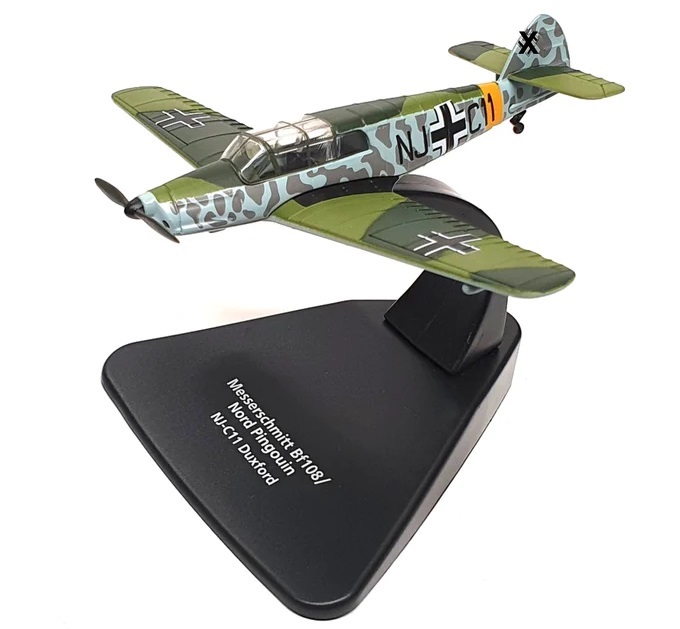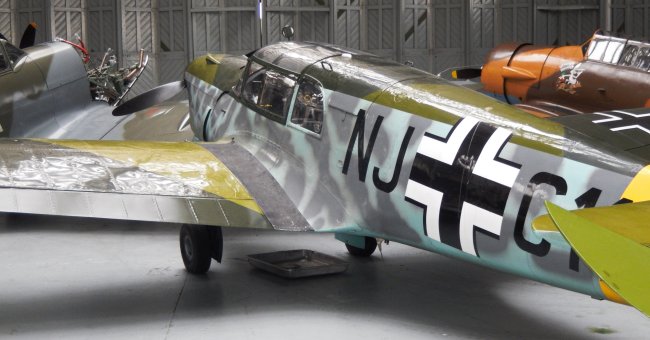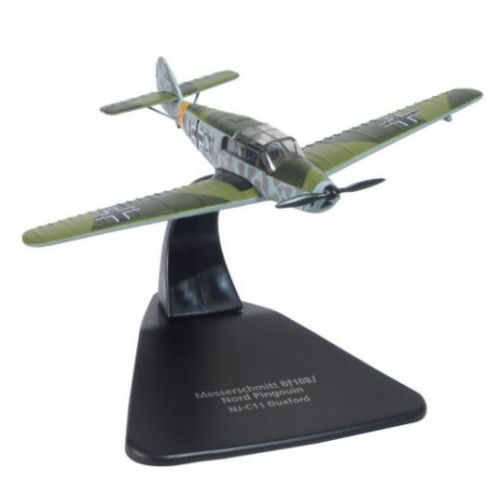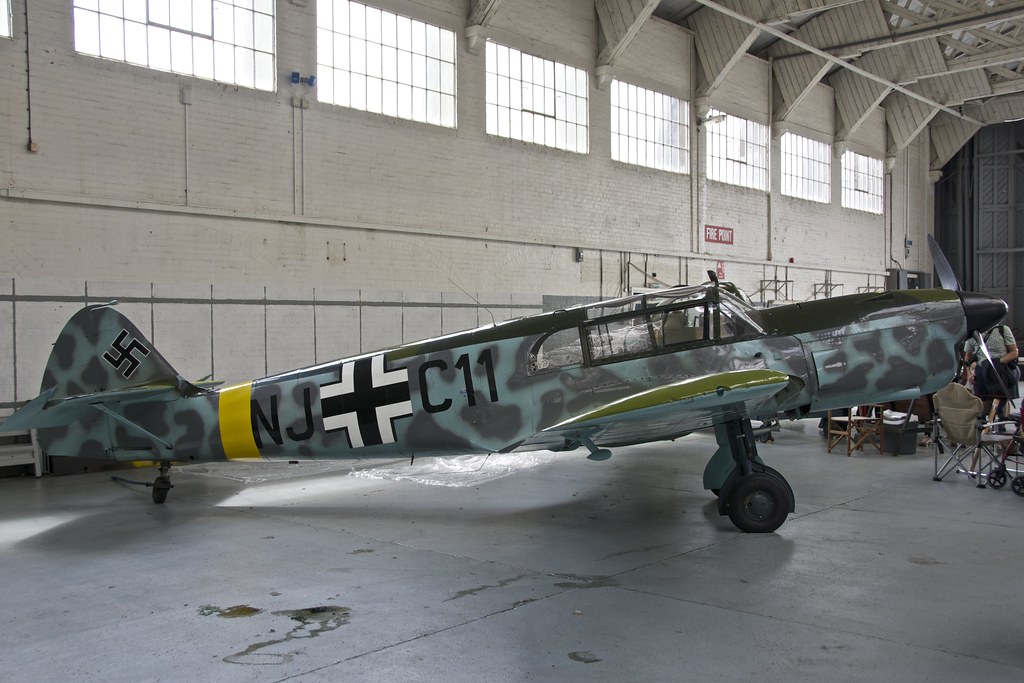Messerschmitt Bf108 Taifun/ Nord Pingouin – NJ+C11, Preserved Duxford 2023
Add to compare2 in stock
£16.99
2 in stock
Oxford Aviation 1/72 scale AC107: Messerschmitt Bf108 Taifun/ Nord Pingouin serial NJ+C11, currently preserved in full airworthy condition at Duxford Museum, Cambridgeshire. With fixed raised undercarriage and a display stand
Length 4.5 inches Wingspan 5.5 inches
PLEASE NOTE: 2 of the photos show the real thing on its wheels. The model comes in the in flight (wheels up) configuration only.
The Nord Pingouin was a re-engined Messerschmitt Bf108 Taifun, built by S.N.C.A.N. in France after the end of WW2. This 1945 built example with a Renault 230HP 6Q.10B engine saw French Air Force service as ‘121’ before finding it’s way to the French civil register in 1962 as ‘F-BGVX’. It then joined the British register in 1965 as ‘G-ATBG’. Being the only ‘Messerschmitt’ available, it then flew regularly as the ‘bad guy’ at UK airshows, often departing the scene trailing smoke and pursued by a Spitfire. Well known owner-pilot Lyndsay Walton commented at the time that he had been ‘shot down’ more times than anybody else in history!
It is now registered to a company in Hong Kong, but remains firmly in the UK.
Originally designated the M 37, the Messerschmitt Bf 108 Taifun (English: “Typhoon”) was designed as an all metal four-seat sports/recreation aircraft for competition in the 4th Challenge de Tourisme Internationale (1934). The M 37 prototype flew first in spring 1934 powered by a 250 PS (247 hp, 184 kW) Hirth HM 8U inverted-V engine, which drove a three-blade propeller.
Although it was outperformed by several other aircraft in the competition, the M 37’s overall performance marked it as a popular choice for record flights. Particular among these traits was its extremely low fuel consumption rate, good handling, and superb takeoff and landing characteristics. One of the first major changes made to the production variants was to adapt the fuselage for a four-seat configuration.
The Bf 108A first flew in 1934, followed by the Bf 108B in 1935. The Bf 108B used the Argus As 10 air-cooled inverted V8 engine. The nickname Taifun (German for ‘typhoon’) was given to her own aircraft by Elly Beinhorn, a well known German pilot, and was generally adopted.
The BWF Company (latter Messerschmitt A.G.) designed the Messerschmitt Bf-108 Taifun in 1934. The original design was for a light tourist double seater, developed for the German team taking part in the 1934 international air race Challenge. Even though the Challenge wasn’t a great success for the Bf-108 as the best German pilot Theo Osterkamp only came in fifth, the RLM still ordered 32 Bf-108s.
The production of the improved version, the Bf-108B, was set-up in November 1935. The B version was redesigned to be a four-seater with a new Argus As 10C engine. The Bf-108B was a very modern light aircraft with an all-metal airframe, retractable undercarriage, adjustable propeller, and with excellent flight characteristics. The Bf-108 took part in many air races and record flights and the first foreign pilot who tested the Bf-108 was Charles Lindberg. He said that it was one of the world’s best aircraft in its class.
The military version of the Taifun was the Bf-108B-2 and was acquired by the Luftwaffe in 1939. It was widely employed during the war years by all operational Luftwaffe units as a light liaison aircraft. In 1941 the new version, the Bf-108D, replaced the B version on the production line. An Argus As 10R engine powered the D version and included the new Argus automatically adjustable propeller and improved fuel assembly. The production was transferred to France in 1942, where 170 Bf-108D were completed before the liberation of France in 1944. French production continued after the war where another 115 aircraft under the name of “Nord 1000” were manufactured.
In total 626 military Taifuns, versions B-2 and D-1, were produced except at least 180 civilian or export version Bf-108 B-0 and B-1. The Luftwaffe employed most of them, but many other air forces used this fine and popular aircraft. The Hungarian AF had 8 Taifuns, both the Italians and Rumanians had 3, the USSR bought two and Switzerland and Yugoslavia had 12 each. One aircraft was used in Chile, one or two in Japan and one was in Australia. The Bulgarian AF had 6 and at least one was in Spain. One Bf-108B-1, coded XC44, was operated by the US embassy in Berlin. Two Bf-108B-1s were flown by the German embassy in London but the RAF confiscated these two aircraft in 1939.After the war, one Bf-108B-2 was flown in Czechoslovakia, two in Poland, one in Denmark and one in Sweden. Some 115 Bf-108Ds ( Nord 1000) were used by the French AF and Navy until the late 50’s. Many of the surviving Taifuns were flown a long time after the war, and some of them are still in airworthy condition today.
Soon after the first production aircraft began to roll off the assembly line in Augsburg, several Bf 108s had set endurance records.
The Bf 108 was adopted into Luftwaffe service during World War II, where it was primarily used as a personnel transport and liaison aircraft. The aircraft involved in the Mechelen Incident was a Bf 108.
A famous raid using a Bf 108 B-2 Trop and a Heinkel He 111 H-16 medium bomber was achieved in North Africa on 21st January 1942 known as the Sonderkommando Blaich raid.
Production of the Bf 108 was transferred to occupied France during World War II and production continued after the war as the Nord 1000 Pingouin.
| Weight | 0.9 kg |
|---|





